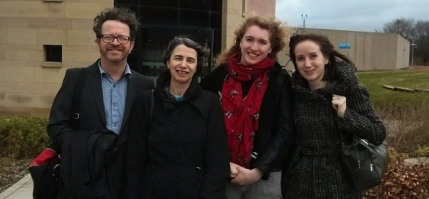Behind bars: Issues of prison labour and a visit to Shotts

On 17th March 2014 a group of representatives of the University of Edinburgh visited HMP Shotts near Glasgow, to learn more about the type of work activities prisoners undertake in Scottish prisons.
The visit came about following a change to the code of conduct of the Worker Rights Consortium, which reports on working conditions in factories in university apparel supply chains, to recommend banning prison labour in our garment supply chains. With procurement staff at the university doubting this change, I investigated debates surrounding the issue of prison labour in this blog post. Scottish Prison Service subsequently invited a group of us to see prison work in person.
HMP Shotts is a maximum security male prison, currently housing 530 prisoners, with over half on life sentences. The prison was newly built only 18 months ago, so is very well equipped in terms of spaces for education and workshops, and efforts have been made to reduce energy consumption. The prison Governor, Jim Kerr, Procurement Manager of Scottish Prison Service, David Wares, and Corporate Affairs Manager at Scottish Prison Service, Martin Birrell, were happy to answer our many questions on how the prison, and the prisoner work element in particular, operate. We received a tour of education facilities including a library, IT room, language classes, an art workshop and a prison magazine publishing project, and of work activities including woodwork, bike repair and recycling.
The issue of prison labour is complex, and practices evidently vary from prison to prison, as well as from country to country. Scottish Prison Service offer an ‘engagement’ package to prisoners, which includes work, education and other services such as counselling, with prisoners who choose to engage in such activities for around 20 hours a week receiving around £11 a week in credit for phone calls and small purchases. While there is some negotiation about the balance between such activities, work is a requirement. Currently four prisoners at HMP Shotts choose not to ‘engage’ in such activities, so they only receive a minimal amount of credit each week. During the visit we discussed a range of ways in which outside organisations and companies can get involved, including providing training in exchange for prisoner work, and offering work placements to prisoners on day release, with the possibility of offering them a job when they leave prison. I look forward to discussing the pros and cons of these initiatives (both for prisoners and for the wider society) in more detail with colleagues and students in the months to come.
Strangely, the atmosphere in the prison felt quite positive and friendly, with good relations between staff and prisoners, prisoners working together on projects, and those with particular skills becoming peer educators. Yet there is evidently a side we didn’t see – there are high rates of drug abuse inside the prison, smuggling in of mobile phones to use to get involved in crime outside, and incidences of violence. And it could be considered worrying that the shelves in the library in the ‘true crime’ section were particularly empty! Indeed, the prison staff reminded us that Shotts houses the most dangerous prisoners in Scotland…





Recent comments